Identification of Damage Modes and Critical States for FRP/Steel-Concrete Composite Beams Based on Acoustic Emission Signal Analysis
Abstract
:1. Introduction
2. Experimental Procedures
2.1. Fabrication of the Fiber Reinforced Polymer (FRP)/Steel-Concrete Beam
2.2. Test Equipment and Loading Protocol
3. Data Processing Method
3.1. Determination of Clustering Parameters
- Define a k-order adjacent relationship. Calculate the distance between arbitrary samples i and j; if i and j are “close enough”, then this is regarded as connected.
- Construct the weight matrix W. If i and j are connected, then the weighted value Wij is calculated by Equation (1); otherwise, Wij = 0:
- Calculate the Lr of the r-th feature. Laplacian score Lr is calculated by the ratio of the sum of the adjacent matrix and corresponding variance, as shown in Equation (2). The small Lr value implies the stronger cluster representation ability:
- Calculate the mutual information entropy Ixy. The mutual information entropy Ixy of arbitrary features x and y is defined in terms of their probabilistic density functions p(x), p(y), and p(x,y), as shown in Equation (3):
- Eliminate redundancy. Normalize the Ixy by the self-information entropy Ixx (NIxy = Ixy/Ixx). For a given threshold ε, NIxy > ε means that x and y are highly dependent; thus, x or y should be discarded based upon their Lr value.
- Determine the best cluster features. By repeating step (5), all redundancy among two arbitrary variables can be eliminated; only “K’” typical features that have high representative power and low information redundancy are retained eventually.
3.2. The Self-Adaptive Real-Time Clustering (SARTC) Strategy
- Determine parameters R and C. The parameter R controls the splitting between classes, while parameter C controls the merging between classes. The parameter R can be determined as the average distance between all samples, while parameter C can be valued as 0.8~2.0 R upon data structure.
- Cluster each sample. Construct the first cluster and center by the first sample. For the subsequent samples x(i), construct the distance vector d = [d1, d2, …] as the distance of x(i) to each cluster center C(j). If dj min < R, put the x(i) to the j-th cluster, and update the cluster numbers and centers based on Equations (4) and (5):
- Inter-class merging. If the distance of two arbitrary centers is D(i, j) < C, then clusters i and j should be merged together, and the corresponding cluster number and center can be updated according to Equations (6) and (7):
- Update the clustering outcomes. All data matrices are supposed to be re-clustered based on the adjacent criterion after the merging operation, so as to guarantee a higher precision.
- Visualization of the clustering outcomes. Two-dimensional correlativity scatter chart or three-dimensional histogram are supposed to visualize the clustering boundaries and centers.
3.3. The Acoustic Emission (AE) Intensity Analysis
4. Damage Modes Identification Based on the Self-Adaptive Real-Time Clustering (SARTC) Strategy
4.1. Acoustic Emission (AE) Feature Selection
4.2. Real-Time Clustering and Validity Analysis
4.3. Damage Modes Analysis for Fiber Reinforced Polymer (FRP)/Steel-Concrete Composite Beams
5. Damage Condition Evaluation
5.1. Overall Condition Evaluation Based on Acoustic Emission (AE) Intensity Analysis
5.2. Local Quantitative Evaluation Based on Acoustic Emission (AE) Energy Fitting
6. Conclusions
Author Contributions
Funding
Data Availability Statement
Acknowledgments
Conflicts of Interest
References
- Zhang, C.T.; Li, Y.Y.; Wu, J.J. Mechanical Properties of Fiber-Reinforced Polymer (FRP) Composites at Elevated Temperatures. Buildings 2023, 13, 67. [Google Scholar] [CrossRef]
- Xian, G.J.; Zhou, P.; Bai, Y.B.; Wang, J.Q.; Li, C.G.; Dong, S.C.; Guo, R.; Li, J.H.; Du, H.Q.; Zhong, J. Design, preparation and mechanical properties of novel glass fiber reinforced polypropylene bending bars. Constr. Build. Mater. 2024, 429, 136455. [Google Scholar] [CrossRef]
- Guo, R.; Xian, G.J.; Li, C.G.; Hong, B. Effect of fiber hybrid mode on the tension-tension fatigue performance for the pultruded carbon/glass fiber reinforced polymer composite rod. Eng. Fract. Mech. 2022, 260, 108208. [Google Scholar] [CrossRef]
- Li, Y.Y. Experimental Investigation, Analysis and Design Methods for FRP/Steel-Concrete Composite Beam-Column Bridges Systems. Ph.D. Thesis, Dalian University of Technology, Dalian, China, 2023. [Google Scholar]
- Huang, H.; Wang, W.W.; Dai, J.G.; Brigham, J.C. Fatigue Behavior of Reinforced Concrete Beams Strengthened with Externally Bonded Prestressed CFRP Sheets. J. Compos. Constr. 2017, 21, 4016108. [Google Scholar] [CrossRef]
- Li, Y.Y.; Chen, J.; Shi, S.Y.; Hu, L.Y.; Xu, X. Study of the design and flexural performance of an innovative Fiber Reinforced Polymer/steel-concrete composite beam. Adv. Struct. Eng. 2023, 26, 121–136. [Google Scholar] [CrossRef]
- Du, Y.; Gao, D.; Chen, Z.; Deng, X.; Qian, K. Experimental study on the flexural behavior of square high-strength concrete-filled steel tube beams with different CFRP wrapping schemes. Compos. Struct. 2023, 304, 116325. [Google Scholar] [CrossRef]
- Kudus, S.A.; Bunnori, N.M.; Mustaffa, N.K.; Jamadin, A. Investigation on Acoustic Emission Parameters due to Fatigue Damage of Concrete Beams with Variable Notched Depth. Int. J. Concr. Struct. Mater. 2022, 16, 29. [Google Scholar] [CrossRef]
- Qiu, X.; Xu, J.; Xu, W.; Yang, Q.; Wang, F.; Yuan, J. Diagnosis of damage evolution process for asphalt mixtures using pattern recognition with acoustic emission signals. Constr. Build. Mater. 2021, 280, 122536. [Google Scholar] [CrossRef]
- Tang, W.; Lin, H.; Chen, Y.; Feng, J.; Hu, H. Mechanical Characteristics and Acoustic Emission Characteristics of Mortar-Rock Binary Medium. Buildings 2022, 12, 665. [Google Scholar] [CrossRef]
- Xu, Y.; Wang, H.; Li, M.; Li, P.; Zhao, P.; Ji, A.; Liu, L.; Liu, Y. Evaluation Method for the Bearing Capacity of Reinforced Concrete Beams Based on the Kaiser Effect. Buildings 2023, 13, 2003. [Google Scholar] [CrossRef]
- Wang, Y.; Chen, G.; Wang, Y.; Han, B.; Wan, B.; Hao, Q.; Bai, Y. Tensile strain and damage self-sensing of flax FRP laminates using carbon nanofiber conductive network coupled with acoustic emission. Compos. Struct. 2022, 290, 115549. [Google Scholar] [CrossRef]
- Qiu, J.; Yang, Q.; Qiu, X.; Xiao, S.L.; He, L.Y.; Hu, G.H. Use of acoustic emission for exploring characteristics and behaviors of mixed-mode fracture process of asphalt mixtures. Mater. Struct. 2022, 55, 199. [Google Scholar] [CrossRef]
- Yang, S.; Gao, Y.; Liu, X.; Wang, G.; Song, L.; Bao, C. Evolution of the Fracture Characteristics in a Rockburst under Different Stress Gradients. Buildings 2022, 12, 1927. [Google Scholar] [CrossRef]
- Gutkin, R.; Green, C.J.; Vangrattanachai, S.; Pinho, S.T.; Robinson, P.; Curtis, P.T. On acoustic emission for failure investigation in CFRP: Pattern recognition and peak frequency analyses. Mech. Syst. Signal Process. 2011, 25, 1393–1407. [Google Scholar] [CrossRef]
- Sayar, H.; Azadi, M.; Ghasemi-Ghalebahman, A.; Jafari, S.M. Clustering effect on damage mechanisms in open-hole laminated carbon/epoxy composite under constant tensile loading rate, using acoustic emission. Compos. Struct. 2018, 204, 1–11. [Google Scholar] [CrossRef]
- Li, D.; Du, F.; Chen, Z.; Wang, Y. Identification of failure mechanisms for CFRP-confined circular concrete-filled steel tubular columns through acoustic emission signals. Smart. Struct. Syst. 2016, 18, 525–540. [Google Scholar] [CrossRef]
- Ding, Y.; Nie, M.; Xu, Y.; Miao, H. A Classification Method of Earthquake Ground Motion Records Based on the Results of K-Means Clustering Analysis. Buildings 2024, 14, 1831. [Google Scholar] [CrossRef]
- Mansouri, T.; Ravasan, A.Z.; Gholamian, M.R. A Novel Hybrid Algorithm Based on K-Means and Evolutionary Computations for Real Time Clustering. Int. J. Data. Warehous. Min. 2014, 10, 1–14. [Google Scholar] [CrossRef]
- Liu, Y.; Zhang, L.; Li, Z.; Chen, Z.; Huang, K.; Guo, L. Investigation on damage evolution of open-hole plain woven composites under tensile load by acoustic emission signal analysis. Compos. Struct. 2023, 305, 116481. [Google Scholar] [CrossRef]
- Zang, W.; Wang, Z.; Jiang, D.; Liu, X. A Kernel-Based Intuitionistic Fuzzy C-Means Clustering Using Improved Multi-Objective Immune Algorithm. IEEE Access 2019, 7, 84565–84579. [Google Scholar] [CrossRef]
- Du, F.; Li, X.; Li, D.; Shen, W. Self-adaptive real-time clustering analysis and damage pattern recognition for steel tube confined reinforced concrete structures through acoustic emission signals. Struct. Control Health Monit. 2022, 29, e3071. [Google Scholar] [CrossRef]
- Tsangouri, E.; Aggelis, D.G. A review of acoustic emission as indicator of reinforcement effectiveness in concrete and cementitious composites. Constr. Build. Mater. 2019, 224, 198–205. [Google Scholar] [CrossRef]
- Yun, H.; Choi, W.; Seo, S. Acoustic emission activities and damage evaluation of reinforced concrete beams strengthened with CFRP sheets. NDTE Int. 2010, 43, 615–628. [Google Scholar] [CrossRef]
- Sagar, R.V.; Prasad, B.; Kumar, S.S. An experimental study on cracking evolution in concrete and cement mortar by the b-value analysis of acoustic emission technique. Cem. Concr. Res. 2012, 42, 1094–1104. [Google Scholar] [CrossRef]
- Qin, L.; Guo, C.C.; Sun, W.; Chu, X.X.; Ji, T.G.; Guan, H. Identification of damage mechanisms of polymer-concrete in direct shearing tests by acoustic emission. Constr. Build. Mater. 2022, 351, 128813. [Google Scholar] [CrossRef]
- Gong, Y.; Wu, S.; Ning, C.; Hu, X.; Yi, Z.; Du, H. Shear Performance and Damage Characterization of Prefabricated Basalt Fiber Reactive Powder Concrete Capping Beam Formwork Structure. Buildings 2024, 14, 1701. [Google Scholar] [CrossRef]
- Tsangouri, E.; Remy, O.; Boulpaep, F.; Verbruggen, S.; Livitsanos, G.; Aggelis, D.G. Structural health assessment of prefabricated concrete elements using Acoustic Emission: Towards an optimized damage sensing tool. Constr. Build. Mater. 2019, 206, 261–269. [Google Scholar] [CrossRef]
- Barile, C.; Casavola, C.; Pappalettera, G.; Vimalathithan, P.K. Damage characterization in composite materials using acoustic emission signal-based and parameter-based data. Compos. Part B Eng. 2019, 178, 107469. [Google Scholar] [CrossRef]
- Wu, G.M.; Han, R.Q.; Li, S.L.; Guo, P. Quantitative damage analysis of brick masonry under uniaxial compression and shear using acoustic emission technology. Struct. Control Health Monit. 2022, 29, e3130. [Google Scholar] [CrossRef]
- Abouhussien, A.A.; Hassan, A. The Use of Acoustic Emission Intensity Analysis for the Assessment of Cover Crack Growth in Corroded Concrete Structures. J. Nondestr. Eval. 2016, 35, 52. [Google Scholar] [CrossRef]
- Du, F.; Li, D.; Li, Y. Fracture Mechanism and Damage Evaluation of FRP/Steel-Concrete Hybrid Girder Using Acoustic Emission Technique. J. Mater. Civ. Eng. 2019, 31, 4019111. [Google Scholar] [CrossRef]
- Zhao, Z.; Zhang, R.W.; Cox, J.; Duling, D.; Sarle, W. Massively parallel feature selection: An approach based on variance preservation. Mach. Learn. 2013, 92, 195–220. [Google Scholar] [CrossRef]
- Huang, R.; Jiang, W.; Sun, G. Manifold-based constraint Laplacian score for multi-label feature selection. Pattern Recognit. Lett. 2018, 112, 346–352. [Google Scholar] [CrossRef]
- Murtaza, M.; Sharif, M.; Yasmin, M.; Fayyaz, M.; Kadry, S.; Lee, M.Y. Clothes Retrieval Using M-AlexNet with Mish Function and Feature Selection Using Joint Shannon’s Entropy Pearson’s Correlation Coefficient. IEEE Access 2022, 10, 115469–115490. [Google Scholar] [CrossRef]
- Moshtaghi, M.; Bezdek, J.C.; Erfani, S.M.; Leckie, C.; Bailey, J. Online cluster validity indices for performance monitoring of streaming data clustering. Int. J. Intell. Syst. 2019, 34, 541–563. [Google Scholar] [CrossRef]
- Zhao, W.; Lei, Y.; Yin, P.; Wang, Z.; Zhu, B. Investigation on acoustic emission characteristics and time-space evolution mechanism of interface bond failure of concrete-filled steel tube. J. Build. Struct. 2021, 42, 200–209. [Google Scholar]
- Li, L.; Lomov, S.V.; Yan, X.; Carvelli, V. Cluster analysis of acoustic emission signals for 2D and 3D woven glass/epoxy composites. Compos. Struct. 2014, 116, 286–299. [Google Scholar] [CrossRef]
- Lai, Y.S.; Xiong, Y.; Cheng, L.F. Frequency band energy characteristics of acoustic emission signals In damage process of concrete under uniaxial compression. J. Vib. Shock 2014, 32, 12–19. [Google Scholar]
- Alver, N.; Tanarslan, H.; Tayfur, S. Monitoring fracture processes of CFRP-strengthened RC beam by acoustic emission. J. Infrastruct. Syst. 2016, 23, B4016002. [Google Scholar] [CrossRef]
- GB50292-2015; Standard for Appraisal of Reliability of Civil Buildings. China Architecture Publishing and Media Co., Ltd.: Beijing, China, 2015.

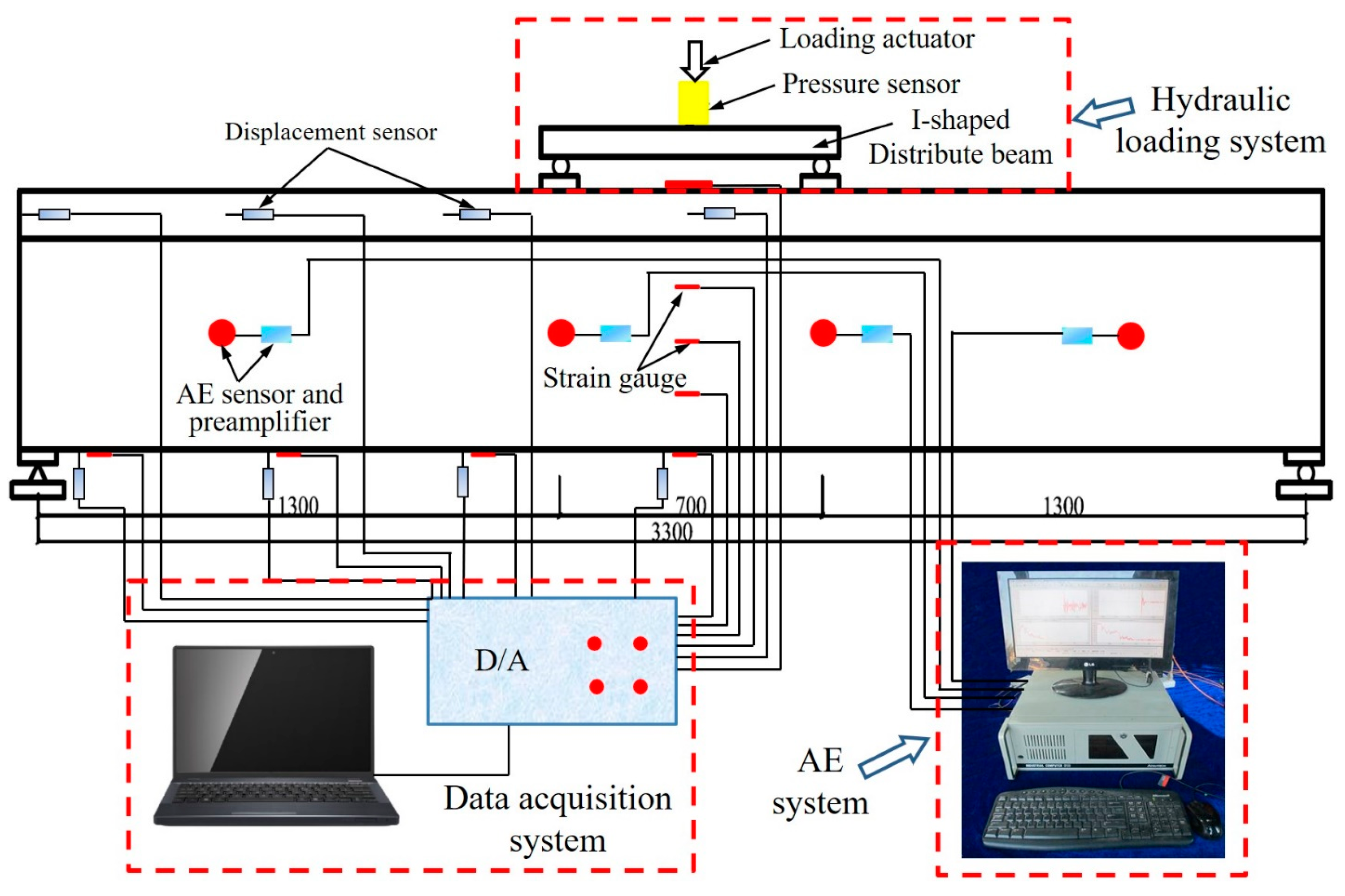


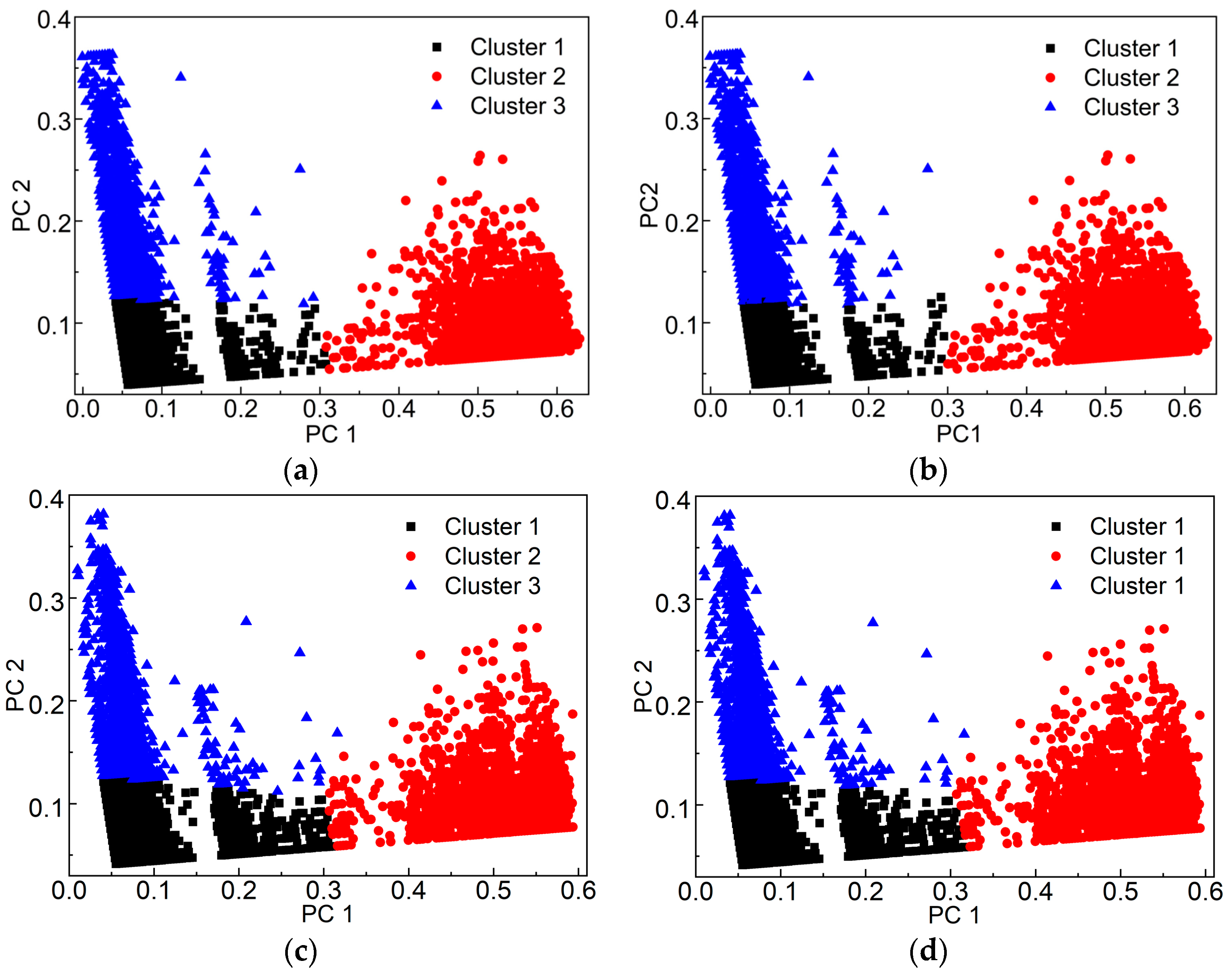



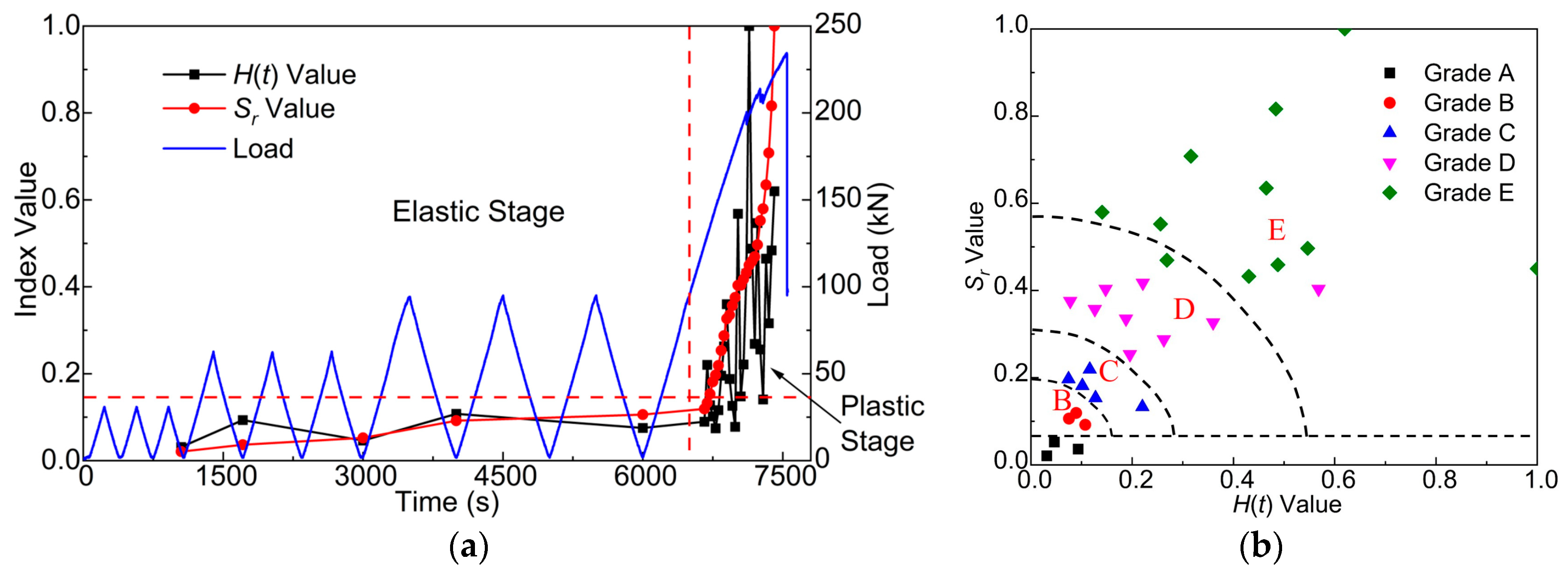
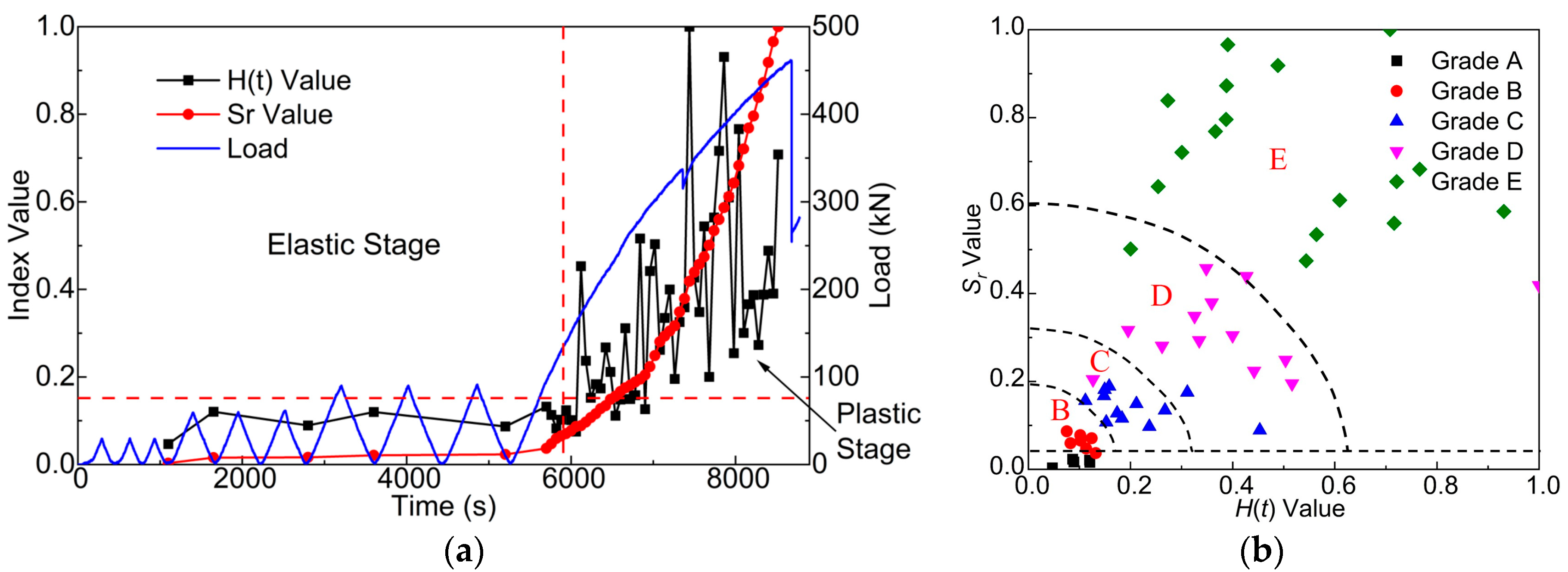
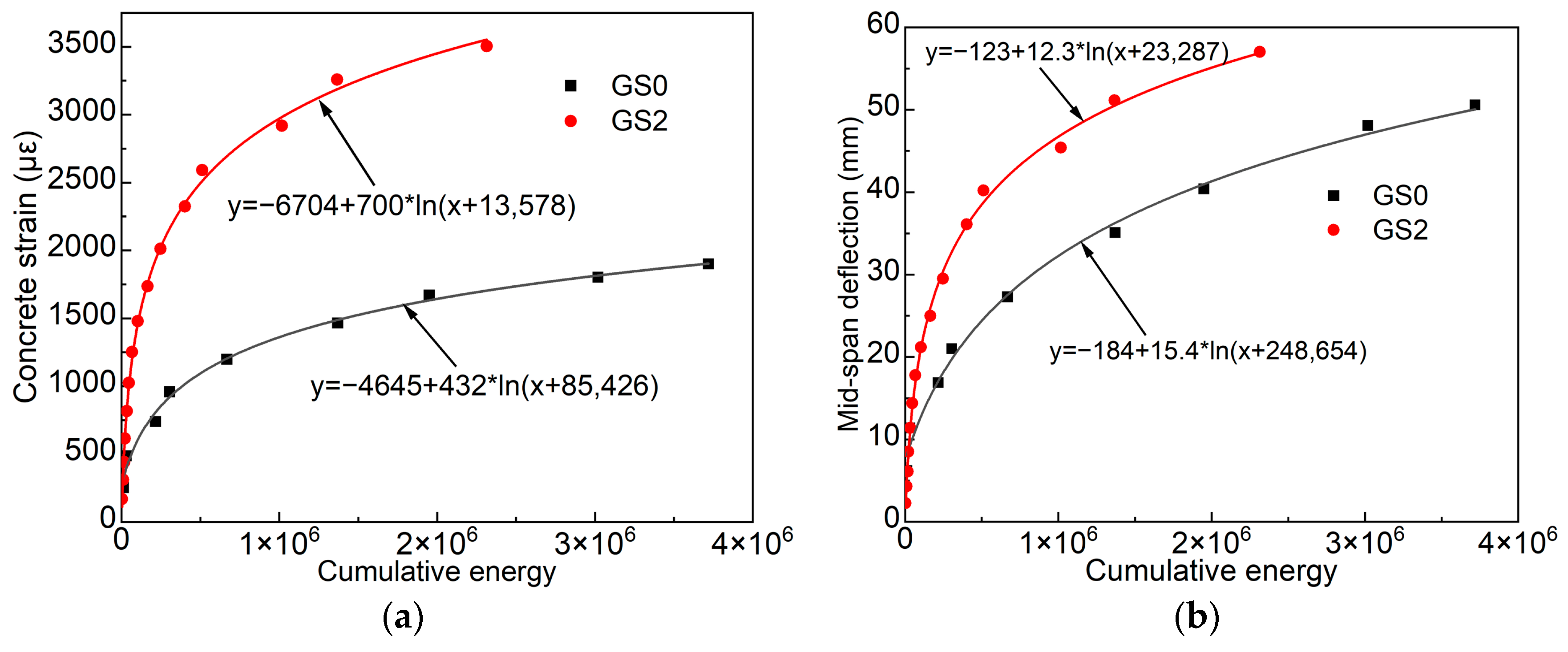
| Material | Yield Strength (MPa) | Tensile Strength (MPa) | Compression Strength (MPa) | Elastic Modulus (GPa) | Thickness (mm) | Elongation (%) |
|---|---|---|---|---|---|---|
| Steel plate | 236.4 | 355.7 | – | 210 | 0 or 2 | 10.9 |
| U-type laminate | – | 192.8 | – | 14.8 | 19 | 1.9 |
| Concrete | – | – | 63.5 | 37.2 | 50 | – |
| Specimen Nameplate | Steel Plate | Concrete | Supporting Span | Top Loading Span |
|---|---|---|---|---|
| GS0 | 0 | C50 | 3300 mm | 700 mm |
| GS2 | 2 mm | C50 | 3300 mm | 700 mm |
| Sensor Type | Sensitive Bandwidth | Threshold | Sampling Rate | PDT (μs) | HDT (μs) | HLT (μs) |
|---|---|---|---|---|---|---|
| R-15a | 50–250 kHz | 40 dB | 3 MSPS | 300 | 800 | 1000 |
| WD | 100–400 kHz | 40 dB | 3 MSPS | 300 | 800 | 1000 |
| Specimen Nameplate | Attributes Ranks | Rise Time | Ring Count | Energy | Duration | Amplitude | Signal Strength | Peak Frequency |
|---|---|---|---|---|---|---|---|---|
| GS0 | Lr Value | 0.5242 | 0.4869 | 1.0142 | 0.5896 | 0.0207 | 1.0144 | 0.0003 |
| Ranks | 4 | 3 | 6 | 5 | 2 | 7 | 1 | |
| GS2 | Lr Value | 0.5908 | 0.5574 | 1.1471 | 0.6881 | 0.0137 | 1.1470 | 0.0005 |
| Ranks | 4 | 3 | 7 | 5 | 2 | 6 | 1 | |
| Is or not retained | No | Yes | No | No | Yes | No | Yes | |
| Specimen Nameplate | Controlling Parameter | Clustering Method | Cluster 1 | Cluster 2 | Cluster 3 |
|---|---|---|---|---|---|
| GS0 | R = 0.3 and C = 1.3 R | SARTC | 14,785 | 1610 | 4193 |
| K = 3 | K-means | 13,589 | 1613 | 5386 | |
| GS2 | R = 0.2 and C = 1.5 R | SARTC | 14,817 | 1603 | 4821 |
| K = 3 | K-means | 13,707 | 1614 | 5920 |
| Average Value of AE Features | Duration (μs) | Ring Count | Energy | Amplitude (dB) | Peak Frequency (kHz) | Signal Number | Energy Contribution Ratio (%) |
|---|---|---|---|---|---|---|---|
| Cluster 1 | 529.90 | 7.47 | 5.30 | 45.11 | 34.99 | 14,785 | 8.65 |
| Cluster 2 | 107.64 | 6.19 | 6.25 | 46.82 | 408.73 | 1610 | 1.11 |
| Cluster 3 | 3149.98 | 58.74 | 195.04 | 64.64 | 38.44 | 4193 | 90.24 |
| Average Value of AE Features | Duration (μs) | Ring Count | Energy | Amplitude (dB) | Peak Frequency (kHz) | Signal Number | Energy Contribution Ratio (%) |
|---|---|---|---|---|---|---|---|
| Cluster 1 | 479.57 | 7.64 | 3.06 | 44.77 | 46.70 | 14,817 | 9.53 |
| Cluster 2 | 98.52 | 6.11 | 4.79 | 47.35 | 410.51 | 1603 | 1.61 |
| Cluster 3 | 1921.7 | 51.75 | 87.67 | 63.11 | 42.35 | 4821 | 88.86 |
| Grades | Appraisal Criterion | Disposal Requirement |
|---|---|---|
| au | The safety meets the requirements of au level and has sufficient bearing capacity | No need to take any measures |
| bu | The safety is slightly lower than the requirement of au level, and the loading capacity was not affected significantly | Appropriate measures can be taken |
| cu | The safety cannot meet the requirements of au level, which significantly affects the bearing capacity | Appropriate measures should be taken |
| du | The safety cannot meet the requirements of au level, which has seriously affected the bearing capacity | Reliable measures should be taken immediately |
Disclaimer/Publisher’s Note: The statements, opinions and data contained in all publications are solely those of the individual author(s) and contributor(s) and not of MDPI and/or the editor(s). MDPI and/or the editor(s) disclaim responsibility for any injury to people or property resulting from any ideas, methods, instructions or products referred to in the content. |
© 2024 by the authors. Licensee MDPI, Basel, Switzerland. This article is an open access article distributed under the terms and conditions of the Creative Commons Attribution (CC BY) license (https://creativecommons.org/licenses/by/4.0/).
Share and Cite
Du, F.; Yang, D.; Li, D. Identification of Damage Modes and Critical States for FRP/Steel-Concrete Composite Beams Based on Acoustic Emission Signal Analysis. Buildings 2024, 14, 2378. https://doi.org/10.3390/buildings14082378
Du F, Yang D, Li D. Identification of Damage Modes and Critical States for FRP/Steel-Concrete Composite Beams Based on Acoustic Emission Signal Analysis. Buildings. 2024; 14(8):2378. https://doi.org/10.3390/buildings14082378
Chicago/Turabian StyleDu, Fangzhu, Dong Yang, and Dongsheng Li. 2024. "Identification of Damage Modes and Critical States for FRP/Steel-Concrete Composite Beams Based on Acoustic Emission Signal Analysis" Buildings 14, no. 8: 2378. https://doi.org/10.3390/buildings14082378




